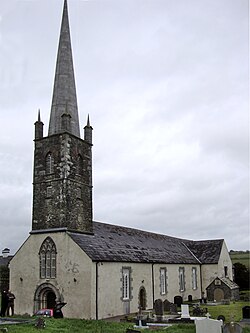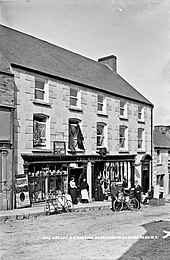Rosscarbery
Rosscarbery
Ros Ó gCairbre | |
|---|---|
Town | |
 Rosscarbery Cathedral | |
 Rosscarbery Location in Ireland | |
| Coordinates: 51°34′40.80″N 09°01′54.12″W / 51.5780000°N 9.0317000°W | |
| Country | Ireland |
| Province | Munster |
| County | County Cork |
| District | Clonakilty |
| Population (2016)[1] | 490 |
| Time zone | UTC+0 (WET) |
| • Summer (DST) | UTC-1 (IST (WEST)) |
| Website | www |
Rosscarbery (Irish: Ros Ó gCairbre, meaning 'Cairbre's wood')[2] is a town in County Cork, Ireland. The town is on a shallow estuary, which opens onto Rosscarbery Bay. Rosscarbery is in the Cork South-West (Dáil Éireann) constituency, which has three seats.
History[]
The area has been occupied from very early times, as is evidenced by the Neolithic remains (pred 2000 BC) such as portal dolmens. The area is very strong in Bronze Age remains - including a number of stone circles. There are also two inscribed stones in Burgatia. The number of ring forts and holy wells witnesses the Iron Age and transition from the Old to the New (Christian) God.[citation needed]
Rosscarbery was home to the School of Ross, a major centre of learning, at one time being a university town, and one of the major cities in Europe, around the 6th century. Due to its popularity as a centre of pilgrimage it was also known as Ros Ailithir ("Wood of the Pilgrims").[3] The hereditary chieftains of the area, or tuath, were the O'Learys, known as Uí Laoghaire Ruis Ó gCairbre, until it passed to Norman control in the early thirteenth century.[4] The entire region had belonged to the ancient Corcu Loígde, of whom the O'Learys were one of the leading septs.[citation needed]
Demographics[]
The town itself has witnessed unprecedented growth in recent times, despite the lack of any major industry in the area, and being just outside the commuter belt for the city of Cork. The majority of new housing is holiday accommodation, which results in an annual swell in population during summer months. According to the 2016 census, the population of the town is 490.
Religion[]
The Church of Ireland's dioceses of Cork, Cloyne and Ross were effectively merged during rationalisation in the 1860s. The bishop of this tridiocese, Paul Colton, is based in Cork.
There is a cathedral in the town, an unusual feature for what now would be considered a sleepy country town. It is a Church of Ireland cathedral - St. Fachtna's Cathedral. St Fachtna's is the smallest cathedral in Ireland, and is the size of a typical parish church.
The Catholic church, in the diocese of Cork and Ross, is St. Fachtna's, dating from 1820.[5]
Places of interest[]

Square[]
An annual horse fair is held in the town's square every year in August.
Beaches[]
Rosscarbery is a tourist destination in the summertime, being in proximity to at least three beaches. The nearest of these, the "Warren Beach", is about a mile from the village, and is designated a blue flag beach, along with the nearby Owenahincha beach. The Warren Beach has experienced extensive coastal erosion in recent times, with remedial works undertaken throughout 2004/2005. Rosscarbery Pitch & Putt Club is located at the beach.
Antiquities[]
Bohonagh is a recumbent stone circle located 2.4 km east of Rosscarbery. It dates to the bronze age and a boulder-burial is located nearby. [6] (grid ref: 308 368, Latitude: 51.580102N Longitude: 8.998987W[7])
Castle Salem is also near the town, and was the home to the Morris family from around 1660 until the early 1800s. The castle is now a guest house and run by the family who bought the castle in 1895.
Transport[]

The town is located along the N71 national secondary road through West Cork. Clonakilty is nearby, further along the road to Cork city, a distance of forty miles. The nearest airport is Cork Airport.
Sport[]
The town has a strong tradition of GAA, its local team being Carbery Rangers, founded in 1887. In November 2003, Carbery Rangers won their first ever football County Junior A title, and subsequently a Junior Munster, Intermediate County, Munster, and All-Ireland titles. The club has since graduated to the senior ranks.
Rosscarbery Rowing Club competes at regattas in West Cork and at the Irish Coastal Rowing Federation Championships each August.
People[]
Fachtna of Rosscarbery (died c. 600), founder of Ros Ailithir monastery.
The poet Airbertach mac Cosse was lector and superior of Ros Ailithir monastery, where he died in 1016.
Also connected with Rosscarbery is William Thompson (1775-1833), the Irish political and philosophical writer and socialist reformer.
Rosscarbery was also home to one of the leaders of the Irish Fenian movement, Jeremiah O'Donovan Rossa.
Tom Barry, a leader of the Irish War of Independence is associated with the town. Meda Ryan's biography - the standard reference text on Tom Barry - states that Barry was born in Kerry to Cork parents, and the 1901 census records the Ryan family living in Killorglin at that time.[8] (Barry's father [also Thomas] was posted to Killorglin barracks as an RIC constable.)[9] Tom Barry had moved to Rosscarbery with his family by 1911,[10] and a Rosscarbery house bears a plaque to this effect. In his memoirs (Guerrilla Days in Ireland) Barry recalls riding a cow through the town's main street to amuse other boys. There is a plaque on the site of the former RIC Barracks, beside the current Garda Station, commemorating the taking of the RIC Barracks by Tom Barry's Flying Column in March 1921.[11]
John Hodnett, a rugby union player for Munster.[12]
Annalistic references[]
See Annals of Inisfallen (AI)
- AI924.1 Kl. Gothbraid, grandson of Ímar, went by sea westwards and took the hostages of the south of Ireland by sea to Ros Ailithir.
- AI933.2 Repose of Ólchobar, abbot of Ros Ailithir.
- AI954.2 Repose of Dub Inse, learned bishop of Ireland, and of Cellachán, king of Caisel, and of Éladach the learned, abbot of Ros Ailithir, and of Uarach, bishop of Imlech Ibuir, and of Célechair, abbot of Cluain Moccu Nóis and Cluain Iraird, and of Cormac Ua Maíl Shluaig, learned sage of Mumu, and of Lugaid Ua Maíl Shempail, abbot of Domnach Pátraic, and of Cenn Faelad son of Suibne, anchorite of Cluain Ferta Brénainn.
See also[]
- List of abbeys and priories in Ireland (County Cork)
- List of towns and villages in Ireland
References[]
- ^ "Sapmap Area - Settlements - Rosscarbery". Census 2016. CSO. April 2016. Retrieved 18 August 2018.
- ^ "Ros Ó gCairbre / Ross Carbery". logainm.ie. Irish Placenames Commission. Retrieved 16 March 2020.
- ^ McNamara, Martin (2000). The Psalms in the early Irish church. Sheffield: Sheffield Academic Press. pp. 68. ISBN 9781850759256.
- ^ O'Flanagan, P. and Buttimer, C.G. Cork History and Society, Interdisciplinary Essays on the History of an Irish County, Geography Publications, Dublin 1993 p. 216
- ^ "Rosscarbery Parish". corkandross.org.
- ^ Weir, A (1980). Early Ireland. A Field Guide. Belfast: Blackstaff Press. p. 113.
- ^ "Bohonagh". The Megalithic Portal. Retrieved 11 June 2008.
- ^ 1901 census - Killorglin/Langford
- ^ 1901 census - Barry's father the 3rd entry (B T)
- ^ 1911 census - Rosscarbery/Fair Lane
- ^ Old RIC barracks, Rosscarbery - Plaque image Archived 2012-03-31 at the Wayback Machine
- ^ "U20 Grand Slam winner Hodnett to debut as Munster name team to face Southern Kings". The42. 12 February 2020. Retrieved 14 February 2020.
External links[]
- Rosscarbery
- Towns and villages in County Cork
- Clíodhna

